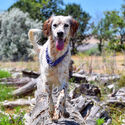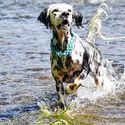Beware of Algae for Summer Swimming Safety
July 1, 2021
The dog days are close at hand, and with a record heatwave happening as we speak, what better way to beat the heat than to head down to your favorite swimming hole with "Rover" in tow. Few things are as rewarding as a romp in the river or pond with your pup, particularly the variety that enjoy a good fetch and retrieve.
My setters are shy on the game of fetch, but a good swim is a home run when the temperatures soar into the 90s and beyond. One of their favorite spots is right in Waitsburg, beneath the main street bridge. Swallows nest under the bridge, and like any classy bird dog, the girls are content to swim against the current all afternoon, simply to feel like they are gaining on the purple-backed, aviator barn swallows, accosting them from overhead, diving, and pulling off at the last moment. Those birds must hit something like four "Gs" when they finally peel off just a couple of feet from the water.
While my setters now love the water, it wasn't always so. I recall the days when we had only young Finn and a rescue German shepherd fitting the poster child for the Meriam-Webster dictionary definition of the word "doofey," should that ever be a recognized word (which it should be). Anyhow, doofey would wade while Finn would dip a toe and commence with panic. Eventually, Ali and I taught Finn to swim by wading out with her and supporting her belly while she learned the "doggy paddle" is far more effective than flailing in chaos. But, once she got it, there was no stopping her.
Whether you have a cabin on a lake, head down to the old town bridge, or maybe journey out to a recreation area on the Snake River, there is always a slight risk of being in the wrong place at the wrong time regarding cyanobacteria.
What exactly are cyanobacteria, you ask? I guarantee you've heard of blue-green algae. Blue-green algae is a significant threat to dogs and humans and occur when water temperatures rise in July and August and are often coupled with a high nutrient load that may result from something like a storm runoff event. While these algae infrequently occur in our local area, they do show up occasionally and can lead to quick illness and death if ingested.
When the conditions are right, algae reproduce ferociously, forming water-clouding densities referred to as "blooms." And a blue-green algae bloom doesn't always appear blue-green. Instead, it may present as reddish-purple or brown, making it hard to differentiate from other more typical algae blooms. Blooms are often seen on the water surface as algae float up at night. Wind and waves carry it to the shore, where it can collect in mats or foam, which may be more common in backwater areas. The danger is significant enough that the Environmental Protection Agency published a set of national standards for microcystins and cylindrospermopsin (blue-green algae toxins) in recreational or drinking water in May 2019.
When heading out for a little weekend water fun, remember these few tips to keep you and your furred family members safe from blue-green algae.
Avoid water when:
It's slimy, looks foamy, is scummy, or has mats on the surface of the water.
The color is unusual. Harmful algal blooms can be blue, bright green, brown, or red and may look like paint floating on the water.
The water stinks. Some harmful algae may produce a nauseating smell.
If you think your dog has gotten into a harmful algae bloom:
Rinse them off immediately. Wear gloves to protect yourself and give your dog a thorough rinse in clean, fresh water.
Watch for diarrhea, vomiting, weakness or staggering, drooling, difficulty breathing, and convulsions or tremors. Symptoms can arise anywhere from 15 minutes to several days after exposure. Take pets to the vet immediately if they show these symptoms.
Report the bloom to your state's health department.
Walla Walla County Community Health department 509-524-2650
Columbia County Public Health (509) 382-2181
Washington Department of Ecology Washington State Toxic Algae (nwtoxicalgae.org)
U.S. Army Corps of Engineers, Walla Walla District Recreation (https://www.nww.usace.army.mil/Missions/Recreation/)














Reader Comments(0)